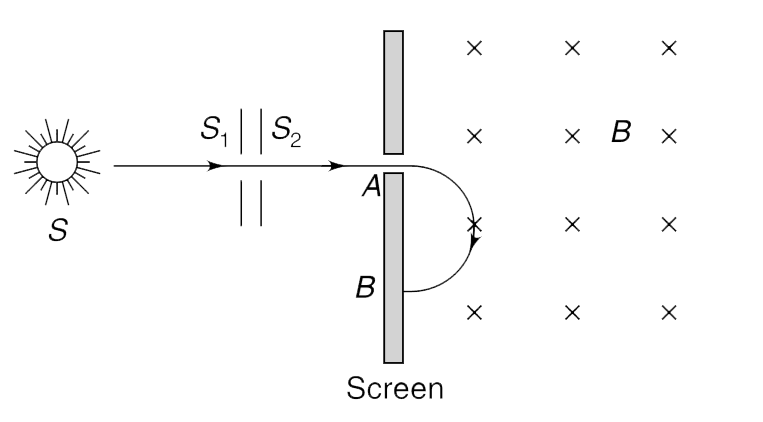A source (s) of beta particles contains a radioactive isotope X. The emitted beta particles are passed through two parallel slits s1 and s2 to get a narrow parallel beam. This beam is made to enter a uniform magnetic field (B). The particles follow semicircular trajectories and are found to hit the screen at all points from A to B the distance AB is equal to 2a. The reaction for decay of a nucleus of X is
X→Y+.0−1e+→v
Calculate the minimum difference in mass of a nucleus of X and Y. mass of an electron is m and charge on it its e.

The correct Answer is:a2e2B22mc2
Step by step video, text & image solution for A source (s) of beta particles contains a radioactive isotope X. The emitted beta particles are passed through two parallel slits s_(1) and s_(2) to get a narrow parallel beam. This beam is made to enter a uniform magnetic field (B). The particles follow semicircular trajectories and are found to hit the screen at all points from A to B the distance AB is equal to 2a. The reaction for decay of a nucleus of X is XrarrY+._(-1)^(0)e+vecv Calculate the minimum difference in mass of a nucleus of X and Y. mass of an electron is m and charge on it its e. by Physics experts to help you in doubts & scoring excellent marks in Class 12 exams.
Topper's Solved these Questions
Similar Questions
Knowledge Check
- Question 1 - Select One
β− particle in radioactivity is emitted by:
ACoversion of proton to neutronBOutermost orbitCConversion of neutron to protonDβ− particle is not emitted - Question 2 - Select One
β - particle is emitted in radioactivity by
Aconversion of proton to neutonBfrom outermost orbitCconversion of neutron to protonDnone of these. - Question 3 - Select One
β-particle is emitted in radioactivity by
AConversion of proton into neutronBfrom outermost orbitCconversion of neutron into protonDβ-particle is not emitted
In radioactive decay process, the negatively charged emitted β-particles are
View SolutionIn radioactive decay process, the negatively charged emitted β-particles are
View SolutionA radioactive nucleus emits a beta particle. The parent and daughter nuclei are:
View SolutionThe particles emitted by radioactive decay are deflected by magnetic field. The particles will be
View SolutionIn radioactive decay process, the negatively changed emitted β−particle are
View Solution

